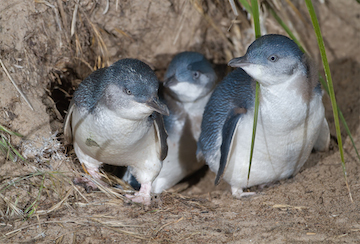410416-little penguins.jpg

Little Penguin family exiting burrow, Bruny Island, Tasmania, Australia. Credit: JJ Harrison, Wikipedia, Attribution-ShareAlike 3.0 Unported license.
The people who named the world’s smallest penguin suffered a serious lack of imagination. They called it the little penguin, or, because it has blue feathers instead of black, the little blue penguin. Yet this little creature has some of the most interesting habits of all penguins.
The little penguin lives along the coastlines of Australia and New Zealand. An adult is about a foot tall and weighs a couple of pounds. To avoid predators, the penguins head out to sea at the crack of dawn, when the sky is still dark, and they don’t return until dusk. When they hit the shore they scurry for cover. Later, they make their way to their own burrows, which they dig in the sand or make in crevices between rocks.
And despite its size, the little penguin is noisy — especially during breeding season. So many people who live near their colonies find them a bit of a nuisance.
Even so, the penguins are holding their own — so far. The population may total a million or more. But loss of habitat, competition from fishing fleets, and increased numbers of dogs, foxes, and other predators are starting to take a toll.
And the changing climate could be an even bigger problem. The penguins feed in waters with a limited temperature range. And the anchovies and sardines that make up much of their diet prefer that same range. But their traditional home waters are warming up — and are forecast to get a lot warmer by the end of the century. That could leave the little penguin with a little population as well.

